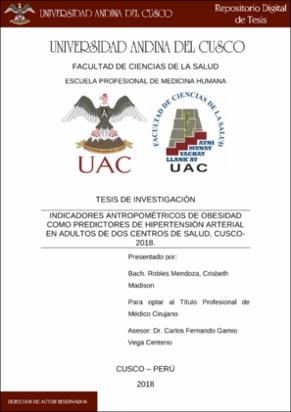| dc.contributor.advisor | Gamio Vega Centeno, Carlos Fernando | |
| dc.contributor.author | Robles Mendoza, Crisbeth Madison | |
| dc.date.accessioned | 2018-06-26T22:49:04Z | |
| dc.date.available | 2018-06-26T22:49:04Z | |
| dc.date.issued | 2018-04-10 | |
| dc.identifier.uri | https://hdl.handle.net/20.500.12557/1753 | |
| dc.description.abstract | Antecedentes: La obesidad afecta a 650 millones de personas ocasionando 2.8 millones de muertes cada año. En el Perú, el 2016 se encontró que el 36.5% de los peruanos eran obesos. Igualmente, los niveles de hipertensión arterial en el Perú se incrementaron; para el año 2011 la prevalencia fue de 23.3% según el estudio TORNASOL II. Una forma de predecir la aparición de hipertensión arterial es usar los indicadores antropométricos de obesidad siendo los más importantes la circunferencia abdominal y el índice cintura estatura en ambos sexos. En estudios alrededor del mundo tanto en las mujeres y varones el indicador con mayor predicción fue el índice cintura estatura incluso mejor que la circunferencia abdominal. Métodos: Se realizó un estudio transversal prospectivo con una muestra de 342 pacientes de ambos Centros de Salud que cumplieron los criterios de inclusión. Para determinar el mejor indicador de obesidad se utilizó la curva ROC determinando el área bajo la curva (AUC) que se consideró positivo si era mayor a 0.5 con un intervalo de confianza al 95%, considerando un indicador discriminativo si no contenían el valor de 0.5. Los valores se consideraron estadísticamente significativos si el valor de “p” fue menor a 0.05. Resultados: Del total de pacientes evaluados se obtuvo que el 33.62% de los participante en el estudio tuvieron hipertensión arterial, en estadio I fueron 25.73% y en estadio II 7.89%. Se encontró que el mejor indicador antropométrico de obesidad como predictor de hipertensión arterial en ambos sexos fue la circunferencia abdominal con un AUC=0.742 y un IC 95% [0.687 – 0.796] con valor de p=0.000; seguido del índice cintura estatura con un AUC=0.733 con un IC 95% [0.678 – 0.789] y p=0.000. En el caso de los varones ninguno de los indicadores tuvo un AUC mayor a 0.5 considerándolos con bajo valor discriminativo para hipertensión arterial. En el caso de las mujeres el mejor indicador antropométrico fue el índice cintura estatura con un AUC=0.782 y un IC 95% [0.721 – 0.843] p=0.000. Conclusiones: En el presente estudio se evidenció que el mejor indicador antropométrico de obesidad como predictor de hipertensión arterial en ambos sexos fue la circunferencia abdominal seguido del índice cintura estatura. En el caso del sexo femenino, el mejor indicador fue el índice cintura estatura. | es_PE |
| dc.description.abstract | Background: Obesity affects 650 million people, causing 2.8 million deaths each year. In 2016 it was found that the 36.5% Peruvians were obese. Likewise, the levels of arterial hypertension in Peru increased and for 2011 the prevalence of this disease was 23.3% according to the TORNASOL II study. One way to predict the onset of hypertension is using the anthropometric indicators of obesity. The most important indicator is the abdominal circumference and the waist- height index in both genders. In studies around the world in both women and men, the indicator with the highest prediction was the waist-height ratio, even better than the abdominal circumference. Methods: It was performed a prospective cross-sectional study with a sample of 342 patients from both Health Centers that met the inclusion criteria. To determine the best indicator of obesity, the ROC curve was used, determining the area under the AUC curve that was considered positive if it was greater than 0.5. The confidence interval will be 95%, taking it with a better discriminator if it did not contain the value of 0.5. The values obtained were statistically significant with a “p” value less than 0.05. Results: From the total patient it was obtained that 33.62% of the participants in the study had hypertension, in stage I they were 25.73% and in stage II 7.89%. It was found that the best anthropometric indicator of obesity as a predictor in both genders was the abdominal circumference with an AUC = 0.742 and an IC 95% [0.687 - 0.796] with a value of p = 0.000, followed by the waist-height ratio with an AUC = 0.733 with an IC 95% [0.678 - 0.789] and p = 0.000. In the case of males, none of the indicators had an AUC greater than0.5, considering them to have low discriminative value for hypertension. In the case of women, the best anthropometric indicator was the waist-height ratio with an AUC = 0.782 and a 95% CI [0.721 - 0.843] p = 0.000. Conclusions: In the present study it was evidenced that the best anthropometric indicator of obesity as a predictor of hypertension in both genders was the abdominal circumference followed by the waist-height ratio. In case of female, the best indicator was the waist-height ratio. | en_US |
| dc.description.uri | Tesis | es_PE |
| dc.format | application/pdf | es_PE |
| dc.language.iso | spa | es_PE |
| dc.publisher | Universidad Andina del Cusco | es_PE |
| dc.rights | info:eu-repo/semantics/openAccess | es_PE |
| dc.rights.uri | https://creativecommons.org/licenses/by-nc-nd/2.5/pe/ | es_PE |
| dc.source | Universidad Andina del Cusco | es_PE |
| dc.source | Repositorio Institucional - UAC | es_PE |
| dc.subject | Hipertensión | es_PE |
| dc.subject | Circunferencia abdominal | es_PE |
| dc.subject | Indice--Masa corporal | es_PE |
| dc.subject | Indice--Cintura | es_PE |
| dc.title | Indicadores antropométricos de obesidad como predictores de hipertensión arterial en adultos de dos centros de salud, Cusco-2018. | es_PE |
| dc.type | info:eu-repo/semantics/bachelorThesis | es_PE |
| thesis.degree.name | Médico Cirujano | es_PE |
| thesis.degree.grantor | Universidad Andina del Cusco. Facultad de Ciencias de la Salud | es_PE |
| thesis.degree.level | Titulo Profesional | es_PE |
| thesis.degree.discipline | Medicina Humana | es_PE |


